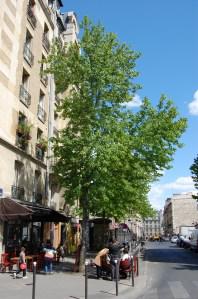Position: Flourishes in full sun to partial shade.
Soil: Moist but well drained.
Flowering period: Spring.
Eventual Height: 25m
Eventual Spread: 12m
Hardiness: USDA Zone 6a-10b
Family: Altingiaceae
Liquidambar styraciflua is a deciduous tree with a broadly conical habit. It has interesting ‘winged’ shoots, which persist on the smaller twigs giving them a very distinctive appearance. It foliage is palmate, similar to that of a Maple, with five or seven lobes and a glossy mid-green in colour becoming orange then red and purple in autumn. The leaves will also give off a sweet scent when crushed. This tree is monoecious and its green inflorescence is yellow in spring, held separately on male and female branches and can be intermittent in Britain. The fruit is spikey, green and globose.
Native to North America and Mexico the Liquidambar genus was first described by Spanish naturalist Hernandez but was introduced to Britain by the missionary plant hunter John Bannister in 1681. The common name for this tree, the Sweetgum, was give to it because when the bark is cut a sweet liquid is exuded, this liquid has been used in perfume
The name Liquidambar was given to it by Hernandez in reference to its aromatic gum, which he described as ‘liquid amber’, with styraciflua is derived from the Latin storax meaning ‘sweet gum’ and flua meaning ‘flowing’ also in reference to its aromatic gum.

Liquidambar styraciflua fruit (14/05/2011, Paris)
The landscape architect may find this plant is useful as a beautiful specimen tree providing beautiful autumn colour. This tree is a good street tree due to its upright habit and tolerance of urban pollution..
Popular cultivars of this plant include L. styraciflua ‘Lane Roberts’ which has deep green foliage that turns a blackened crimson in autumn and styraciflua ‘Worplesdon’ whose five lobed foliage turns a deep orange and yellow in autumn.
This plant will prefer acidic or neutral soil but it may be clay, loam or sand based. It may be placed in a sheltered or exposed location facing any aspect.
Ecologically this plant will cater for the larvae of some species of Lepidoptera. Birds and other animals will occasionally inhabit its canopy.
The Royal Horticultural Society have given the cultivars L. styraciflua ‘Worplesdon’ and L. styraciflua ‘Lane Roberts’ their prestigious Award of Garden Merit.
Maintenance: Removal of dead and damaged material should be carried out in late autumn or winter.

